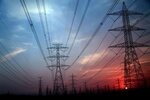05/18/2004
Wind energy on the rise in New Zealand
The opening of TrustPower's expanded Tararua windfarm marks the beginning of an era of rapid growth for wind power in New Zealand, says Energy Minister Pete Hodgson. Mr Hodgson says that by the of this year New Zealand will have nearly four times as much wind generation as it does now. The Minister says New Zealand has a very good and largely untapped wind resource, and the technology is rapidly becoming more economic. TrustPower's expansion of the Tararua wind farm is the first of several wind power developments that will come onstream in the near future.
The windfarm, in the Manawatu Gorge area near Palmerston North, is increasing from 48 to 103 turbines, generating enough electricity to supply 28,000 average households. Mr Hodgson says his extra wind power is onstream now because the project was assisted by Kyoto Protocol carbon credits from the government. Electricity from wind farms and other new clean energy projects reduces the need for generation from gas or coal. This reduces the greenhouse gas emissions that help cause climate change. The government recognises this saving by passing on carbon credits, whose financial value helps make projects like the Tararua wind farm viable.
Other wind farm projects that will get carbon credits, if they proceed as planned, are Meridian Energy's proposed Te Apiti windfarm of about 90 megawatts, in the Manawatu; New Zealand Windfarms' proposed Te Rere Hau Windfarm of about 50 megawatts, also in the Manawatu; the Wainui Hills Wind Farm company's proposed plant of up to 30 megawatts, near Wellington; Genesis' proposed Hau Nui Wind Farm extension of five megawatts, in the Wairarapa; and Genesis' proposed Awhitu Wind Farm of about 19 megawatts, South Auckland. Mr Hodgson says New Zealand's wind generation capacity at the end of last year was about 36 megawatts. TrustPower has doubled that by extending Tararua and later this year Te Apiti and Hau Nui are due to come onstream. Wind power is taking off, which is good news for both the electricity system and the environment.
The windfarm, in the Manawatu Gorge area near Palmerston North, is increasing from 48 to 103 turbines, generating enough electricity to supply 28,000 average households. Mr Hodgson says his extra wind power is onstream now because the project was assisted by Kyoto Protocol carbon credits from the government. Electricity from wind farms and other new clean energy projects reduces the need for generation from gas or coal. This reduces the greenhouse gas emissions that help cause climate change. The government recognises this saving by passing on carbon credits, whose financial value helps make projects like the Tararua wind farm viable.
Other wind farm projects that will get carbon credits, if they proceed as planned, are Meridian Energy's proposed Te Apiti windfarm of about 90 megawatts, in the Manawatu; New Zealand Windfarms' proposed Te Rere Hau Windfarm of about 50 megawatts, also in the Manawatu; the Wainui Hills Wind Farm company's proposed plant of up to 30 megawatts, near Wellington; Genesis' proposed Hau Nui Wind Farm extension of five megawatts, in the Wairarapa; and Genesis' proposed Awhitu Wind Farm of about 19 megawatts, South Auckland. Mr Hodgson says New Zealand's wind generation capacity at the end of last year was about 36 megawatts. TrustPower has doubled that by extending Tararua and later this year Te Apiti and Hau Nui are due to come onstream. Wind power is taking off, which is good news for both the electricity system and the environment.
- Source:
- Online editorial www.windfair.net
- Author:
- Trevor Sievert, Online editorial journalist
- Email:
- press@windfair.net
- Keywords:
- New Zealand, TrustPower, windfarm, wind turbine


























